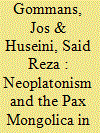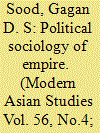| Srl | Item |
| 1 |
ID:
184157


|
|
|
|
|
| Summary/Abstract |
This article argues that ṣulḥ-i kull (peace for all) as a specific term was introduced in the 1590s by a small group of avant-garde Neoplatonists who worked at the court of the Mughal emperor Akbar. It was only in the following century that ṣulḥ-i kull developed into the ethos that became the ideological mainstay of Mughal rule both internally, for its administrative elites, and externally, vis-à-vis their main rivals: the Uzbeks in Central Asia and the Safavids in Iran. The early stages in the making of this ideology can be followed in some detail by studying Akbar's neglected millennial history, the Tarikh-i Alfi. In fact, this vast Mughal world history demonstrates that apart from Neoplatonic akhlāq, there was another important building block that so far has been missing altogether in the making of ṣulḥ-i kull, that is, the practical model of the Pax Mongolica, as established under Chinggis Khan, the most famous of Mughal ancestors. Most crucially, it is in the Tarikh-i Alfi that we find the legacies of Persianate akhlāq and Mongol yasa (law) married to each other. In fact, it was through akhlāq that the peace of the Mongols became the Mughal peace for all.
|
|
|
|
|
|
|
|
|
|
|
|
|
|
|
|
| 2 |
ID:
185806


|
|
|
|
|
| Summary/Abstract |
In this article, Mughal understandings of their own past are reconstructed from the standpoint of Mughal paramountcy in around 1700. That was the moment of the empire's greatest territorial reach, when it knew no peer nor threat. To reconstruct contemporary understandings of how this situation came about, histories of the Mughal empire composed by governing officials of the time are analysed using a novel approach rooted in a particular distinction between constants and contingencies. These understandings allow us to recapture the political sociology of empire as apprehended by the Mughal elites. The article's findings are of value for two reasons. Narrowly construed, they help fill a lacuna in mainstream views on Mughal historiography, traditionally dominated by Akbar and his reign, and imbued with the logic of decline (and of its corollary, the transition to colonialism). More broadly, because of the weight accorded to knowledge of the past in the formation of Mughal ruling elites, the findings provide fresh insights into the cognitive framework within which these elites operated at a moment recognized as highly significant then, and in retrospect.
|
|
|
|
|
|
|
|
|
|
|
|
|
|
|
|